Written response: Puberty and me
Summary of task
Students were involved in a five-week unit of work about puberty and relationships. This involved a focus on personal qualities, rights, responsibilities, and stereotypes and how they are reflected in the media. Students learnt about the importance of making good choices. Some lessons were spent practising effective communication skills to express emotions and ideas and to develop confidence to talk to people in their network if they have questions or concerns. Students also investigated physical, social and emotional changes associated with puberty as well as how to take care of their own body during this time.
Students were asked to:
- summarise key physical and emotional changes experienced during puberty
- suggest strategies or attitudes that might help young people feel positive about themselves during puberty
- make a chatterbox that included facts about puberty, how to gather more information and who they could talk to
- select stereotypical media images and comment on how each image might influence how young people see and feel about themselves and their identity
- choose one of the sample problems and provide a solution
- reply to a letter from a young person who is concerned about some aspect of their body.
Students received these tasks over the course of the unit. They were given extra class time and homework time.
These assessment tasks relate to the focus areas: relationships and sexuality, mental health and wellbeing, and safety.












